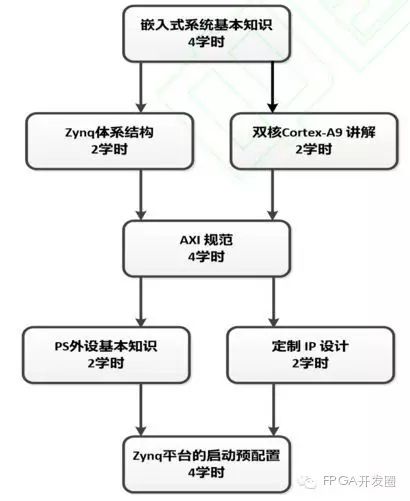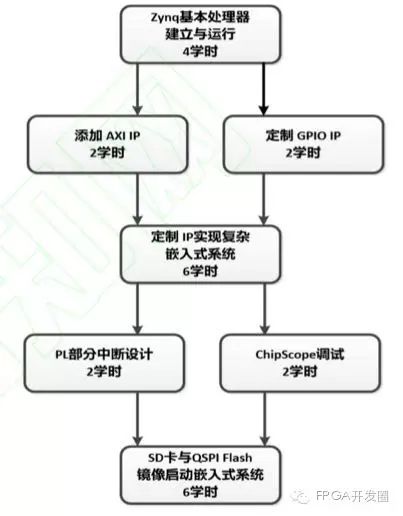Abstract: In response to the issues in traditional embedded systems teaching, this article proposes using the Zynq platform as a practical platform for teaching reform in embedded systems. A new course structure is adopted, oriented towards engineering practice training, driving students to autonomously complete course learning and practical activities. Teaching practice shows that completing embedded system design based on the Zynq platform is very important. It not only consolidates students’ foundational theories but also cultivates their engineering practice abilities, while improving their overall embedded system development capabilities.
As a large number of IP (Intellectual Property) components are integrated into SOC (All Programmable SOC), embedded system design is becoming increasingly complex. At the same time, with the continuous development of design tools and methods, the boundaries between software and hardware in embedded systems have become blurred. However, traditional ARM embedded system courses are highly fragmented in theory and constantly updated in structure, making it difficult for students to form a simple and clear knowledge system in a short period of time. With the advent of big data and the intelligent Internet of Things era, future embedded systems will transform into a fully programmable system based on application requirements, where the entire system will be designed for specific needs within a single chip. This fully programmable implementation process reflects the perfect combination of software serial execution and hardware logical parallel execution, as well as the collaborative debugging and design of software and hardware. In order to cultivate fully programmable embedded engineers, this article combines the teaching and practical experience of the “System on Chip Design” course offered by our department to propose several teaching reform measures based on the Zynq platform.
Zynq is a low-cost development board based on the Xilinx Zynq-7000 AP SOC platform. This development board can implement designs based on Linux, Android, Windows, or other OS/RTOS operating systems. In addition, the rich expansion interfaces on the development board allow users to conveniently access programmable logic and processor systems. The Zynq-7000 device is a combination of the latest semiconductor technology, computer technology, and electronic technology. It combines a fast processor system based on two ARM Cortex-A9 processors with the industry’s fastest and most advanced 28nm FPGA architecture, along with multiple high-speed serial transceivers and an on-chip analog processing module that includes two 1 million samples per second analog-to-digital converters. The core of the Zynq-7000 AP SOC is the dual-core hardened ARM Cortex-A9 microprocessor.
The two ARM Cortex-A9 processors communicate with on-chip memory, SDRAM, flash memory, and peripheral modules through the AXI (Advanced eXtensible Interface) interconnect mechanism. These hardened modules constitute the processor system part of the Zynq-7000 AP SOC, known as PS (Processing System). Each CPU is a Cortex A9 processor with a dedicated NEON co-processor (media and signal processing architecture, which increases instructions for audio, video, 3D graphics, imaging, and language processing) and a double-precision floating-point unit. The on-chip PS connects to the programmable logic of the Zynq device, known as PL (Programmable Logic), through multiple AXI ports. This forms an extremely efficient coupling between the two key components of the Zynq architecture. The programmable logic can be configured by users and connected through an “interconnect” module, allowing for user-defined functions to extend the performance and capabilities of the processor system. A series of interconnect modules work together to route signals between logic modules according to application requirements. Programmable logic software tools can compile RTL applications into bit files, which can then be loaded into programmable logic to configure its functions.
The Zynq-7000 AP SOC platform is an excellent teaching practice platform. As a teaching platform, students can implement the entire process of embedded systems course teaching on this platform, clearly seeing each specific process of implementation. This way, students can truly understand the essence of embedded systems. At the same time, when using this platform to develop embedded applications, students can further enhance the flexibility and reliability of embedded systems.
In order to cultivate fully programmable embedded engineers, we selected the Zynq development board as the teaching platform and adopted a new course structure that includes five major modules: course lectures, foundational knowledge, basic skills, project training, and extension training. The new structure emphasizes the cultivation of students’ engineering training and innovative thinking. The overall course design consists of 66 hours (48 theoretical hours and 18 experimental hours), with 4 credits. The distribution of class hours for each module is shown in Figure 1. To meet the needs of course teaching, we independently compiled the “System on Chip Design Lecture Notes,” “System on Chip Design Experimental Tutorial,” and “System on Chip Design Practical Case Tutorial and Extension Training” based on the original course materials from the Xilinx University Program.

Figure 1 Distribution of Class Hours for Each Module
The course lecture content invites renowned professors or Xilinx instructors to teach students the latest Zynq knowledge, allowing them to understand the latest industry trends and developments. The basic content of the course includes two aspects: foundational knowledge and basic skills. The teaching hours for foundational knowledge are 20, mainly explaining the design methods and processes of embedded systems based on Zynq, as well as the AXI 4-Lite specifications. The knowledge structure is shown in Figure 2. The teaching hours for basic skills are 24, with the basic skills structure shown in Figure 3. Basic skills training is interspersed within the foundational knowledge teaching, serving as a necessary supplement and practice to the foundational knowledge, further enhancing understanding through practical operations. Students exercise their initial embedded system design skills on the Zynq platform, laying the foundation for project training.

Figure 2 Structure of Foundational Knowledge
The project training module is a comprehensive training for students, requiring them to design and implement a commonly used embedded operating system on the Zynq platform, completing the setup of the operating system environment, the implementation of u-boot principles, kernel compilation, and device tree implementation. The Zynq platform provides the following optional training projects: (1) Implementation of the Ubuntu operating system on the Zynq platform (2) Implementation of the uC/OS-III operating system on the Zynq platform (3) Implementation of the CentOS operating system on the Zynq platform

Figure 3 Structure of Basic Skills
The extension training module is designed for students with extra capacity, allowing them to complete innovative designs during their spare time in the second classroom. Adopting the concept of a “pocket” laboratory, introduced by the Xilinx University Program to China, breaks the limitations of experimental time and space, enabling students to implement innovative ideas anytime and anywhere. Students with extra capacity can use the “pocket” laboratory as a second classroom to broaden their knowledge, combining their research interests and directions through self-learning, discovering problems, and purposefully solving them through research practice, thus acquiring new knowledge and continuously enhancing their innovative awareness.
The new teaching platform and knowledge system have been implemented in the “System on Chip Design” course for the 12th and 13th batches of Electronic Information Science and Technology. Teaching surveys indicate that 95% of students are “very satisfied,” 90% believe they will benefit from this course in their future work, and 97% are interested in the “pocket” laboratory. The Zynq platform organically combines theoretical teaching and practical teaching of embedded systems, transforming the traditional structure of embedded knowledge and stimulating students’ innovative thinking. Especially the concept of the “pocket” laboratory, this “portable” laboratory greatly stimulates students’ interest, integrating interest and learning, and is gradually becoming an effective way to cultivate innovative talents.
[Recommended Reading]
The drone platform based on Zynq SoC is continuously growing
How to digitize hundreds of signals with a single Xilinx FPGA chip?
[Literacy Post] What is a heterogeneous multiprocessor system, and why do we need it?
Xilinx FPGA brings you into the 8K visual era
IM Corporation launches the Origami ecosystem and introduces the Origami B20 development module for the first time
